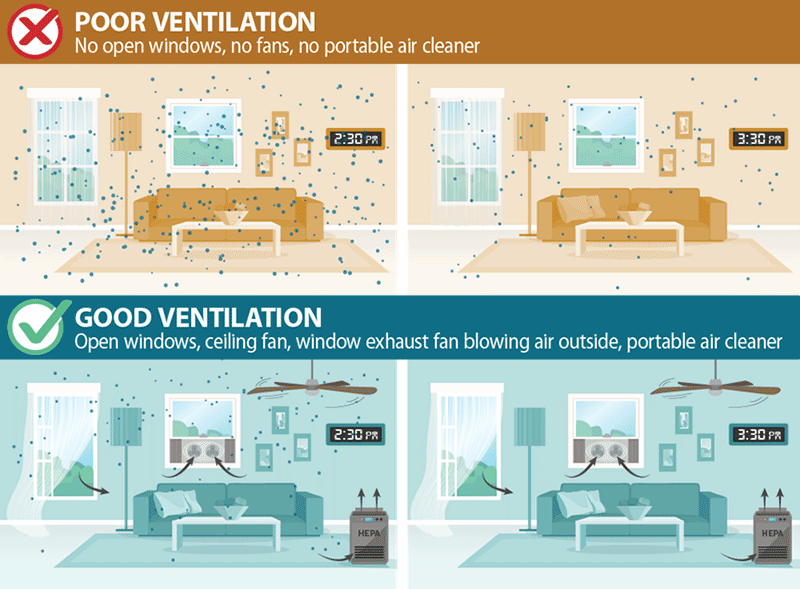Introduction
Proper ventilation is essential for maintaining a healthy and comfortable indoor environment. Whether you are at home, in the office, or any other enclosed space, having good airflow can significantly impact your overall well-being. In this blog post, we will explore the importance of ventilation and discuss effective ways to air out and freshen indoor spaces.
The Importance of Proper Ventilation
Proper ventilation is crucial for maintaining a healthy and comfortable indoor environment. Without adequate air circulation, indoor spaces can become stale, stuffy, and even hazardous to our health. Ventilation plays a vital role in controlling moisture, odors, pollutants, and temperature, ensuring a fresh and pleasant atmosphere inside our homes and workplaces.
The Benefits of Fresh Air
When indoor spaces are properly ventilated, fresh air is constantly introduced and stale air is expelled. This exchange of air brings numerous benefits:
- Improved Air Quality: Ventilation helps remove pollutants, such as dust, allergens, volatile organic compounds (VOCs), and harmful gases, from the air. This reduces the risk of respiratory issues, allergies, and other health problems.
- Reduced Moisture: Proper airflow helps control moisture levels, preventing the growth of mold and mildew. Excessive moisture can lead to structural damage, musty odors, and health risks.
- Temperature Regulation: Ventilation helps regulate indoor temperatures, preventing spaces from becoming excessively hot or cold. This enhances comfort and reduces the need for energy-consuming heating or cooling systems.
- Elimination of Odors: Effective ventilation helps remove unpleasant odors from indoor spaces, ensuring a fresh and inviting environment.
Types of Ventilation
There are two primary types of ventilation: natural ventilation and mechanical ventilation.
Natural Ventilation
Natural ventilation relies on the natural flow of air through open windows, doors, vents, and other openings. It utilizes wind pressure and temperature differences to create airflow. Natural ventilation is often preferred for its energy efficiency and the connection it provides to the outdoor environment. However, it may not always be sufficient, especially in tightly sealed buildings or during extreme weather conditions.
Mechanical Ventilation
Mechanical ventilation involves the use of fans, ducts, and other mechanical systems to control the airflow. It can be centralized or decentralized, and it offers more control over air movement. Mechanical ventilation is particularly useful in buildings where natural ventilation is inadequate or impractical.
Tips for Properly Ventilating Indoor Spaces
Here are some helpful tips to ensure proper ventilation and fresh air circulation in your indoor spaces:
1. Open Windows and Doors
One of the simplest ways to ventilate a space is by opening windows and doors to allow fresh air to enter. Cross-ventilation can be achieved by strategically opening windows on opposite sides of a room, creating a natural airflow.
2. Utilize Ventilation Fans
Install exhaust fans in kitchens, bathrooms, and other areas prone to moisture and odors. These fans help remove stale air and prevent the buildup of humidity, improving air quality.
3. Clean Air Vents and Filters
Regularly clean and maintain air vents, filters, and ducts to ensure unrestricted airflow. Clear any obstructions, such as dust or debris, that may hinder proper ventilation.
4. Consider Mechanical Ventilation Systems
If natural ventilation is insufficient, consider installing mechanical ventilation systems. These systems can efficiently and consistently circulate fresh air throughout the space, ensuring optimal air quality.
Summary
Ventilation plays a crucial role in maintaining indoor air quality, removing pollutants, and preventing the buildup of excess moisture. Without adequate ventilation, indoor spaces can become stale, stuffy, and even hazardous to health. To ensure proper ventilation, it is important to follow a few key steps:
- Open windows and doors regularly to let fresh air in and allow stale air to escape.
- Use fans and air purifiers to improve airflow and filter out impurities.
- Clean and maintain air vents and ducts to avoid blockages and ensure optimal airflow.
- Avoid using synthetic air fresheners and opt for natural alternatives like plants or essential oils.
- Monitor humidity levels and use dehumidifiers or humidifiers when necessary to prevent mold and mildew growth.
By implementing these practices, you can view publisher site create a healthier and more pleasant indoor environment. Ventilation matters, and it is up to us to prioritize it for our well-being and comfort.

Welcome to my website! My name is Benjamin Wollaston, and I am a dedicated professional carpet cleaning technician with a passion for providing exceptional service and ensuring a healthy and clean environment for my clients. With years of experience in the industry, I have developed a deep understanding of carpet cleaning solutions, indoor air quality enhancement, upholstery and furniture care, and flooring alternatives. Learn More Here

